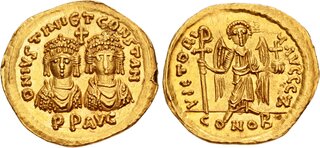| Classical Numismatic Group > Auction 126 | Auction date: 28 May 2024 |
| Lot number: 947 Price realized: This lot is for sale in an upcoming auction - Bid on this lot  | Show similar lots on CoinArchives Find similar lots in upcoming auctions on |
| Lot description: Justin II & Tiberius II Constantine. 578. AV Solidus (20.5mm, 4.40 g, 6h). Constantinople mint, 7th officina. Struck 26 September-5 October. D N IVSTINI ЄT CONSTAN P P AVG, crowned and draped facing busts of Justin and Tiberius; cross above / VICTORIA AVGGG, Angel standing facing, holding long staff surmounted by staurogram and globus cruciger; Z//CONOB. DOC (1); MIB 1 and pl. 10, 1 (this coin cited and illustrated [from a plaster cast copy in the British Museum]); MIBE 1 and pl. 10, 1 (this coin cited and illustrated [from a plaster cast copy in the British Museum]); SB 417. Thin obverse die break, clashing on reverse, minor metal flaw, light edge marks from mount, light hairlines. EF. Extremely rare. One of the absolute supreme rarities of all Byzantine coinage. This example one of the finest preserved of this incredibly difficult issue and recorded by Hahn in MIB as being in the Protonotarios collection in the early 1970's. From the Family of Constantine Collection, assembled with guidance by Roland Michel, Geneva. Ex Glenn Woods Collection (Triton VII, 12 January 2004), lot 1082; Stack's (1 December 1999), lot 40; Sotheby's New York (2 November 1998), lot 121; William Herbert Hunt Collection (Sotheby's New York, 5 November 1990, lot 124; P. N. Protonotarios Collection. The extremely rare joint-reign solidi of Justin II and Tiberius II are attested to by precious few examples. First discovered among the solidi and medallions contained within the remarkable Kyrenia Girdle, the issue instantly became a grail coin for any Byzantine or late Roman gold collection. The example found here is among the finest struck and best preserved of the known examples (which number fewer than ten). Considering the brevity of the joint reign, it is remarkable that such coins were struck, or that any have survived. But the existence of this extremely rare issue proves the ceremonial and legitimizing value of coinage. The production of the joint reign solidi must have been planned and probably implemented well in advance, and attests to the importance attached to such coinage in conveying the ideas of the successful transfer of power or the accession of a new ruler. Succeeding his uncle by marriage, the formidable Justinian I, would have been a daunting task for Emperor Justin II even with his full faculties. Unfortunately, Justin was hampered by ill health, which may have included mental troubles. Pressure from his influential wife Sophia and the imperial court led to the nomination of Tiberius as Caesar in 574. Tiberius proved a competent administrator, and opinion mounted that the junior ruler should be elevated to full co-Augustus. The ailing Justin acceded to this, and Tiberius was elevated as Augustus on September 26th 578. The senior augustus Justin died only nine days later. The Kyrenia Girdle was first discovered in 1902 (though published later in the 1955 Numismatic Chronicle). The incredible belt was ornamented with an unprecedented four six-solidi consular medallions of Maurice Tiberius (dated to 582) along with fifteen solidi including: an IMP XXXXII issue of Theodosius II, three Justin I and Justinian I join reign pieces, one Justin II and Tiberius II joint reign solidus, and ten consular solidi of Maurice, (two of which were later discovered separately). Taken together, the coins demonstrate a consistent theme. The Theodosius issue marked his 42nd year as ruler, equal to the reign of the first emperor Augustus. The joint reign solidi denote dynastic continuity, and the consular issues of Maurice record the preservation of the ancient traditional office in Roman culture. The belt, embellished with over one-half pound of coined gold, must have been a donative presented to a very high ranking official. The pieces were likely selected not for their rarity, but for their propaganda value. Like the Kyrenia Girdle, the joint reign solidi of Justin II and Tiberius, such as this wonderful example, were struck for the same reason-to serve as a tangible reminder of the solidity of the imperial succession. Estimate: 50000 USD |  |



